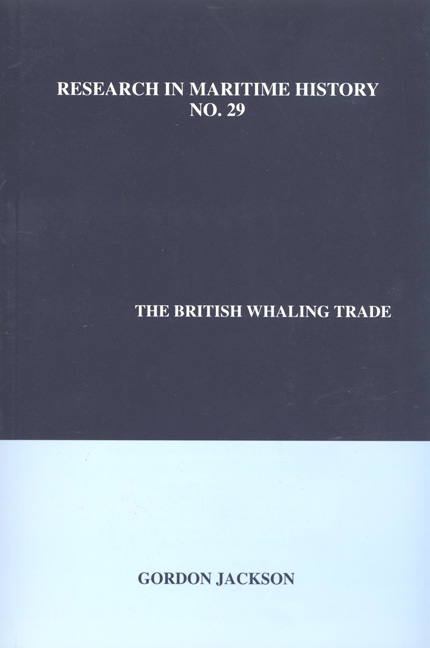Book contents
- Frontmatter
- Dedication
- Contents
- List of Tables in the Text
- List of Appendices
- New Introduction
- Preface
- Part One The Traditional Whaling Trades, 1604-1914
- Chapter 1 Northern Adventures and the Spitsbergen Trade, c. 1604-1670
- Chapter 2 Lost Hopes and Expensive Failures, c. 1670-1750
- Chapter 3 The Rise of the Greenland Trade, 1750-1783
- Chapter 4 The Boom in the Northern Fishery, 1783-c. 1808
- Chapter 5 Expansion South of the Arctic Seas, c. 1776-c. 1808
- Chapter 6 Decline in the North in the Early Nineteenth Century
- Chapter 7 Expansion and Failure of the Southern Fishery, c. 1808-1840
- Chapter 8 The End of the Northern Fishery in the late Nineteenth Century
- Part Two The Modern Whaling Trade, 1904-1963
- Conclusion
- Appendices
- Select Bibliography
- Additional Bibliography
- Index
Chapter 1 - Northern Adventures and the Spitsbergen Trade, c. 1604-1670
from Part One - The Traditional Whaling Trades, 1604-1914
- Frontmatter
- Dedication
- Contents
- List of Tables in the Text
- List of Appendices
- New Introduction
- Preface
- Part One The Traditional Whaling Trades, 1604-1914
- Chapter 1 Northern Adventures and the Spitsbergen Trade, c. 1604-1670
- Chapter 2 Lost Hopes and Expensive Failures, c. 1670-1750
- Chapter 3 The Rise of the Greenland Trade, 1750-1783
- Chapter 4 The Boom in the Northern Fishery, 1783-c. 1808
- Chapter 5 Expansion South of the Arctic Seas, c. 1776-c. 1808
- Chapter 6 Decline in the North in the Early Nineteenth Century
- Chapter 7 Expansion and Failure of the Southern Fishery, c. 1808-1840
- Chapter 8 The End of the Northern Fishery in the late Nineteenth Century
- Part Two The Modern Whaling Trade, 1904-1963
- Conclusion
- Appendices
- Select Bibliography
- Additional Bibliography
- Index
Summary
The origins of whaling are hidden in the mists of mythology and are, perhaps, best left there. When and where man first realised the economic potential of the world's largest animals, and how he was first able to catch them, is a matter for speculation based on inadequate texts. So far as Europe is concerned, medieval commentators, including King Alfred, wrote about a Norwegian whale fishery. Icelanders were reputed to have eaten the whale, and Norman-French gastronomes appreciated its tongue. On both sides of the Channel, and in Scotland, whales were accorded the status of “royal fish” and made the subject of grants and charters assigning the benefits to be had from their stranded carcasses. They were viewed with awe and wonderment, especially from the decks of ships that were smaller than they were, but determined efforts were nevertheless being made to catch them in early modern times in both northern and southern Europe. In the north it had been discovered that certain types of small pilot whales which passed in schools through coastal waters could be encouraged to beach themselves by fishermen raising a din and thrashing the water - as happened in the Norwegian, Icelandic, Orkney and Shetland “fisheries.” In the south the Basques had by the fifteenth century developed something approaching a modern “industry,” as local fishermen went out to attack whales breeding in the Bay of Biscay. It was this Basque fishery, rather than that in the north, which led directly to the modern whaling trade. It was thought for a long time, and recorded by Scoresby, that the whale involved - long since vanished from Biscay - was a type of small fin whale called Balaena rostrata, but modern cetologists believe it to have been a type of medium to large black whale called, as if to prove the point, Balaena biscayensis. The significance of this lies in the fact that, whatever the zoological differences, Balaena biscayensis was simply a smaller version of the great Balaena mysticetus which was to become the chief quarry of the European whaling trade over the next two centuries. In other words, the skills developed over generations in the traditional peasant employment of the Basques could be transferred with a minimum of trouble to the commercial whaling trade.
- Type
- Chapter
- Information
- The British Whaling Trade , pp. 1 - 22Publisher: Liverpool University PressPrint publication year: 2004



